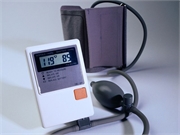Arm Squeezes With Blood Pressure Cuffs Might Aid Recovery After Stroke
By Steven ReinbergHealthDay Reporter

THURSDAY, Oct. 8, 2020 (HealthDay News) -- After administering clot-busting drugs to treat a stroke, using blood pressure cuffs to squeeze each arm might aid recovery, a new, small Chinese study suggests.
In the technique -- called remote ischemic post-conditioning -- the flow of oxygen-rich blood is repeatedly interrupted and restored using blood pressure cuffs on the arms. Earlier studies have found that the technique may prevent tissue damage by helping the body handle changes in blood flow and the damage that may occur from a stroke, researchers say.
"The findings show a promising future prospect of remote ischemic post-conditioning and have important clinical implications," said researcher Dr. Guo-liang Li, of First Affiliated Hospital of Xi'an and Jiaotong University in Xi'an, China.
"As we all know, the therapy has a lot of advantages," he said, calling it noninvasive, easy-to-use, cost-effective and safe.
Even though clot-busting drugs have saved many stroke patients, 32% do not have a favorable outcome. This is partly because blood flow is not completely restored and vessels can clot even after clot-busting drugs are given, Li said.
"Remote ischemic post-conditioning can be a complementary treatment that can improve the prognosis in stroke patients," he said.
This study was done in China, but Li said the technique has also been studied in the United Kingdom, France and Denmark.
For the study, Li's team randomly assigned 68 people (average age: 65) who suffered a stroke. All were treated within 4.5 hours with a medication that dissolves blood clots called tPA. Half also received ischemic post-conditioning therapy.
Over an average of 11 days, post-conditioning participants wore blood pressure cuffs on both arms for 40 minutes, alternating cycles of inflation for five minutes and deflation for three minutes. Treatments were done twice a day.
Stroke recovery was gauged on a scale of no symptoms; no significant disability despite some symptoms; or slight disability. People who had no symptoms after three months were considered to have had a favorable recovery.
Seventy-two percent of those who wore the blood pressure cuff had a favorable recovery, compared with 50% of those who didn't, the researchers found. These findings remained significant even after taking into account age, stroke severity and other factors.
During the trial, two people dropped out -- one because the cuffs caused skin redness and the other because the pressure applied during the procedure was uncomfortable. Researchers don't know how long the treatment is needed to be most effective.
They caution that ischemic post-conditioning is still experimental and isn't something that should be tried on recovering stroke patients at home.
"In the future, more studies are needed to confirm that the combined therapy of clot-busting drugs and remote ischemic post-conditioning is safe and effective in much larger groups of people before this experimental therapy can be performed at home," Li said.
Dr. Larry Goldstein, chairman of the Department of Neurology at the University of Kentucky, reviewed the findings.
"This single hospital study was aimed at determining whether the technique might be helpful in improving outcomes of patients with stroke who were treated with a clot-busting drug and [it] suggests benefit," he said.
But, Goldstein added, the approach was used over an average 11 days -- longer than most U.S. stroke patients stay in the hospital. "This is not part of usual care here," he said.
Although the treatment is probably uncomfortable, Goldstein said the discomfort might be tolerated if it aids in stroke recovery.
"If it did improve outcomes, that [discomfort] would be a reasonable tradeoff," Goldstein said.
But the notion that remote ischemic post-conditioning improves blood vessel function is debatable, he added.
"It would need to be studied in larger, adequately controlled trials in a variety of populations conducted in multiple centers to determine whether it is clinically useful," Goldstein said.
The findings were published online Oct. 7 in the journal Neurology.
More information
Learn more about stroke from the America Stroke Association.

The news stories provided in Health News and our Health-E News Newsletter are a service of the nationally syndicated HealthDay® news and information company. Stories refer to national trends and breaking health news, and are not necessarily indicative of or always supported by our facility and providers. This information is provided for informational and educational purposes only, and is not intended to be a substitute for medical advice, diagnosis, or treatment.

